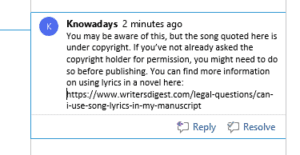
Plagiarism and Copyright in Creative Writing
Plagiarism in creative writing is harder to identify than, say, academic plagiarism. Despite this, proofreaders may want to look out for potential plagiarism and copyright issues in creative writing. To help you navigate these muddy waters, we’ve prepared a quick guide to the basics.
What Is Plagiarism in Creative Writing?
It is hard to define plagiarism in creative writing because creative works often contain similar elements, such as character types, tropes, plot elements, generic settings, etc.
Thus, two stories being similar does not equate to plagiarism. It could just be that two writers had similar ideas. Or, in some cases, an author may be directly referencing or reimagining the work of another writer (Joyce’s Ulysses, for instance, is a creative reworking of the Odyssey).
However, these commonalities may spill over into plagiarism when an author:
- Uses very specific elements of another writer’s work (e.g., unique character names, settings, or plot points that aren’t commonly used in other stories).
- Duplicates passages of text from another writer’s work without crediting them.
Cases like these, where an author takes someone else’s work and passes it off as their own, could be seen as plagiarism unless there is a good reason for the level of similarity (e.g., the author is writing a parody of an existing work and is referencing it deliberately).
Even when an act of plagiarism seems obvious, though, it may not be your business as a proofreader! Unless a client has asked for some form of manuscript critique or substantive editing, it doesn’t matter if their work is unoriginal. It’s their choice to make.
However, you may want to highlight potential plagiarism if it could pose legal problems. And that brings us on to the tricky issue of copyright infringement.
Plagiarism vs. Copyright Infringement
To simplify massively, copyright is a form of legal protection for intellectual property. Thus, if a creative work is copyrighted, only the copyright holder has the right to make and sell copies.
Not all plagiarism poses a copyright issue: Shakespeare’s Macbeth is in the public domain, so you could copy the whole thing and claim it as your own with no legal consequences. You’d have a hard time getting anyone to believe you, admittedly, but that’s a separate issue.
But if an author copies all or part of a copyrighted work, they could get in trouble. And it doesn’t even have to be passing of work as their own. Copyright infringement can include:
- Using a significant portion of a copyrighted work without permission. This could be text from another novel, but it could also be things like song lyrics, poems, images, etc.
- Creating a derivative work using copyrighted elements of an existing work without permission (e.g., a sequel or screenplay based on another writer’s novel).
- Creating a work that is substantially similar to a copyrighted work.
Not everything is covered by copyright in the same way. As well as public domain works, for instance, Creative Commons licensing allows artists to set permissions for specific uses of their work. And copyright laws have exceptions for “fair use,” such as review and parody.
In sum, copyright is very complicated. But we’re not saying you need a law degree to work as a proofreader; it is just something to be aware of when proofreading creative writing.
What to Do About Copyrighted Material in Creative Writing
As noted above, copyright isn’t strictly an issue for proofreaders. The author and publisher will be held responsible for any legal consequences, not you. And if the work already has a publisher, they should have cleared any copyright issues long before proofreading begins.
In most cases, then, you won’t have to worry about plagiarism in creative writing.
However, if you spot something in a document that has been borrowed from a copyrighted work and think your client may not be aware of the issue, you might want to:
- Leave a polite comment for your client noting the potential problem.
- Suggest they seek permission from the copyright holder, cut the copied material, or look for a public domain alternative to the borrowed work.
- Link to a resource with more information or suggest asking a copyright professional.
You might do this, for instance, if you were proofreading a novel for a self-published author and found a copyrighted song quoted in full. You could then leave a comment saying:

That way, you help your client address any problems with copyright or plagiarism before they arise. And by going this extra mile, you boost your chances of getting return business!
Becoming A Proofreader
Ethical proofreading is important to us at Knowadays. And our Becoming A Proofreader course teaches both necessary skills and ethical practices for proofreading.
Check out the free trial today to find out more.





Your email address will not be published.